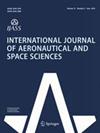Research on the Process of Dispersing the Bullet by a Large-Size Gasbag with Multiple Inlet Nozzles Based on the Fluid–Structure Interaction Method
IF 1.4
4区 工程技术
Q2 ENGINEERING, AEROSPACE
International Journal of Aeronautical and Space Sciences
Pub Date : 2023-09-26
DOI:10.1007/s42405-023-00664-7
引用次数: 0
Abstract
Abstract To meet the needs of the airborne dispenser to disperse large-mass bullets, the dispersal system of large-size gasbag with multiple inlet nozzles was designed and built. The rationality and feasibility of the dispersal system were verified by the experimental study of the interior ballistic process. On this basis, the fluid–structure interaction method was used to simulate and analyze the process of the gasbag propelling the bullet when the number of inlet nozzles is different. The calculation results show that the final shape of the expanded gasbag is pillow shaped, and wrinkles appear at the ends of the long side and in the middle of the short side of the gasbag. The stress at the wrinkles is relatively large, and the stress on the wall of the gasbag with three inlet nozzles is greater than that on the wall of the gasbag with two inlet nozzles. Affected by the changes of flow field in the gasbag and the deformation of the gasbag, the process of the gasbag propelling the bullet is divided into two stages, and there are also two large fluctuation peaks during the change of the acceleration of the bullet. Moreover, the expansion process of gasbag with two inlet nozzles lags behind that of the gasbag with three inlet nozzles, and the maximum acceleration and separation velocity of the bullet are also relatively reduced by 2% and 3%, respectively.基于流固耦合法的多喷嘴大尺寸气囊散弹过程研究
摘要为满足机载点药机对大质量子弹的分散需求,设计并构建了多入口喷嘴大尺寸气囊分散系统。通过内弹道过程的实验研究,验证了该分散系统的合理性和可行性。在此基础上,采用流固耦合方法对不同进口喷嘴数量下气囊推进子弹的过程进行了仿真分析。计算结果表明,膨胀后的气囊最终形状为枕形,在气囊长边两端和短边中间出现褶皱。皱褶处的应力比较大,具有三个进口喷嘴的气囊壁上的应力大于具有两个进口喷嘴的气囊壁上的应力。受气囊内流场变化和气囊变形的影响,气囊推进子弹的过程分为两个阶段,在子弹加速度变化过程中也存在两个较大的波动峰。此外,两个进口喷嘴的气囊膨胀过程滞后于三个进口喷嘴的气囊,子弹的最大加速度和分离速度也相对降低了2%和3%。
本文章由计算机程序翻译,如有差异,请以英文原文为准。
求助全文
约1分钟内获得全文
求助全文
来源期刊

International Journal of Aeronautical and Space Sciences
ENGINEERING, AEROSPACE-
CiteScore
3.10
自引率
11.80%
发文量
111
期刊介绍:
The International Journal of Aeronautical and Space Sciences (IJASS) encourages submission of papers addressing all aspects of aerospace science and technology, which include acoustics, aerodynamics and fluid mechanics, aerospace telecommunications, airworthiness and maintenance, avionics, combustion and propulsion, flight dynamics, guidance and control, flight simulation and operations, low carbon manufacturing, nano application, plasmas and lasers, research instrumentation and facilities, space exploration, structural dynamics and aeroelasticity, structures and materials, and thermomechanics and reacting flows. The journal also addresses the ground and flight tests of aerospace systems including aircraft, air ship, helicopter, microelectromechanical system, missile, satellite, rocket, and UAV.
 求助内容:
求助内容: 应助结果提醒方式:
应助结果提醒方式:


